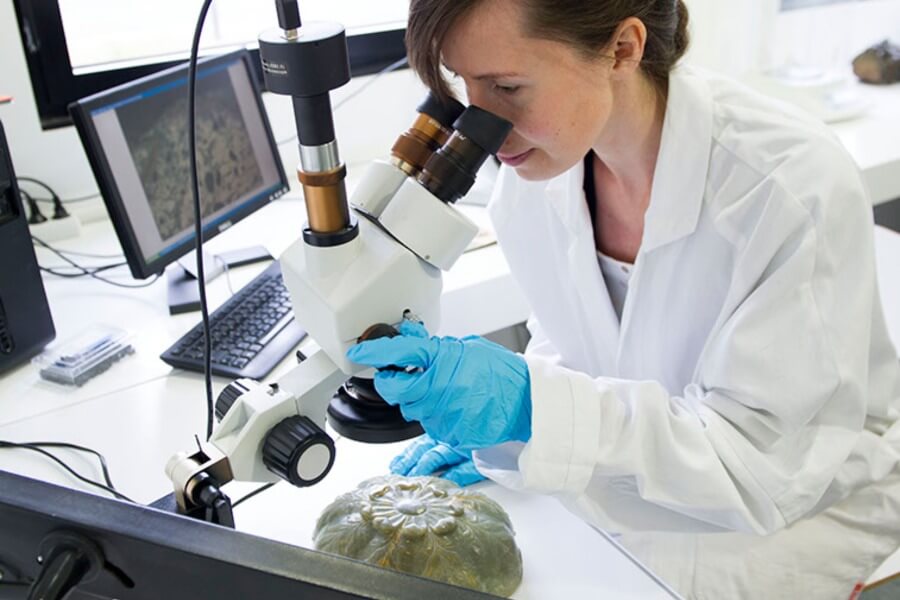
MICROANALYSIS
CIRAM Laboratories and its teams of scientists do everything possible to characterize your works of art and archaeological artifacts. Age testing, material analysis, scanning electron microscopy (SEM), infrared spectrometry, we have state of the art equipment and the best scientists to interpret the results.
Analytical methods tailored to your needs
Archaeological furniture, sculptures, paintings, mural paintings, material characterization or even detection of tool traces, CIRAM adapts its analytical protocol according to your problems and constraints. We use the same procedures as public laboratories for a precise, fast and reliable analysis and research. Discover the scope of microanalysis to date, authenticate and characterize your parts.
The microanalysis of ancient materials
Microanalysis allows us to define the chemical composition of materials, whether they are mineral, metallic or organic. Our teams of doctors will rely on microanalysis to perform age tests and authentication tests. Based on the elemental composition of an alloy, the degree of deterioration of the material and the origin of this degradation, CIRAM’s teams will obtain objective and relevant chronological information to authenticate, and sometimes date, your stone, bronze, silver or gold sculptures or paintings. CIRAM has many analytical techniques that can be combined. We find for example:
- Optical microscopy;
- Electron microscopy (SEM);
- Chemical analysis (EDX) and elemental analysis (EA);
- Raman spectrometry;
- Plasma torch spectrometry (ICP-MS and ICP-AES).

Advanced technologies
With the different methods of microanalysis, it is possible to obtain a lot of chronological information about a work of art. Depending on the composition of the material (bronze, brass, silver, gold, stone…), we will adapt our analytical processes. For example, we will choose scanning electron microscopy (SEM-EDX), and/or Raman spectrometry and/or ICP-AES.
From these analyses, our laboratory scientists perform age tests, identification of fakes and copies, which sometimes lead to dating.

Microanalysis of archaeological material
All the methods of microanalysis in an archaeological context will allow the identification of sediments and mineral deposits, the characterization of the mineralogical composition of terracotta, the definition of the chemical composition of a mortar or a ferrous or non-ferrous metal and the tracing of manufacturing techniques, or the identification of alterations suffered by an object.
CIRAM offers numerous scientific investigations, in order to respond to your archaeological problems, whether it is a study of provenance, characterization of materials, research of ancient techniques, or identification of ancient polychromy. CIRAM’s teams of scientists work on different types of materials such as:
- terracotta (composition, heating, provenance);
- sedimentary deposits or mineral residues;
- ferrous and non-ferrous metals (composition, manufacturing technique, corrosion);
- polychromes (pigment, filler, binder).
Microanalysis applied to stone and metal
To reach a conclusion about the age of a stone or metal object, there is no dating method. Only microanalysis will provide objective and relevant information that will allow to characterize, authenticate, and even date your stone or metal sculptures.
Based on optical microscopy and electron microscopy analyses, CIRAM’s analytical protocol is based on:
- the characterization of the material (nature of the rock, composition of the metal);
- the analysis of the degree of alteration or the degree of corrosion;
- the origin of the alteration or corrosion (natural or artificial);
- the analysis of the superficial deposits (patina or surface treatments).
CIRAM, specialist in the characterization and dating of works of art
Whether it is archaeological furniture or an object of art and heritage, CIRAM laboratories will offer you, depending on the materials, either a dating or an age test.
CIRAM is the only organization to offer sampling and analysis protocols similar to public laboratories. For more information, request a quote.
